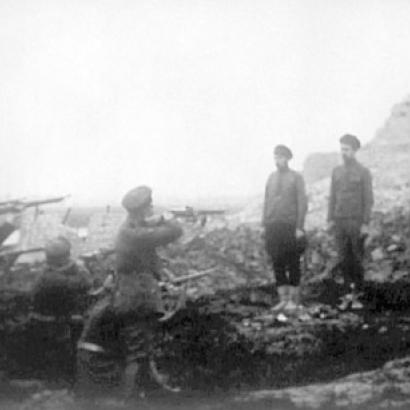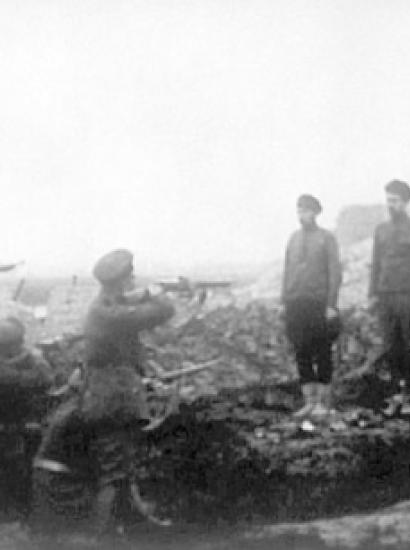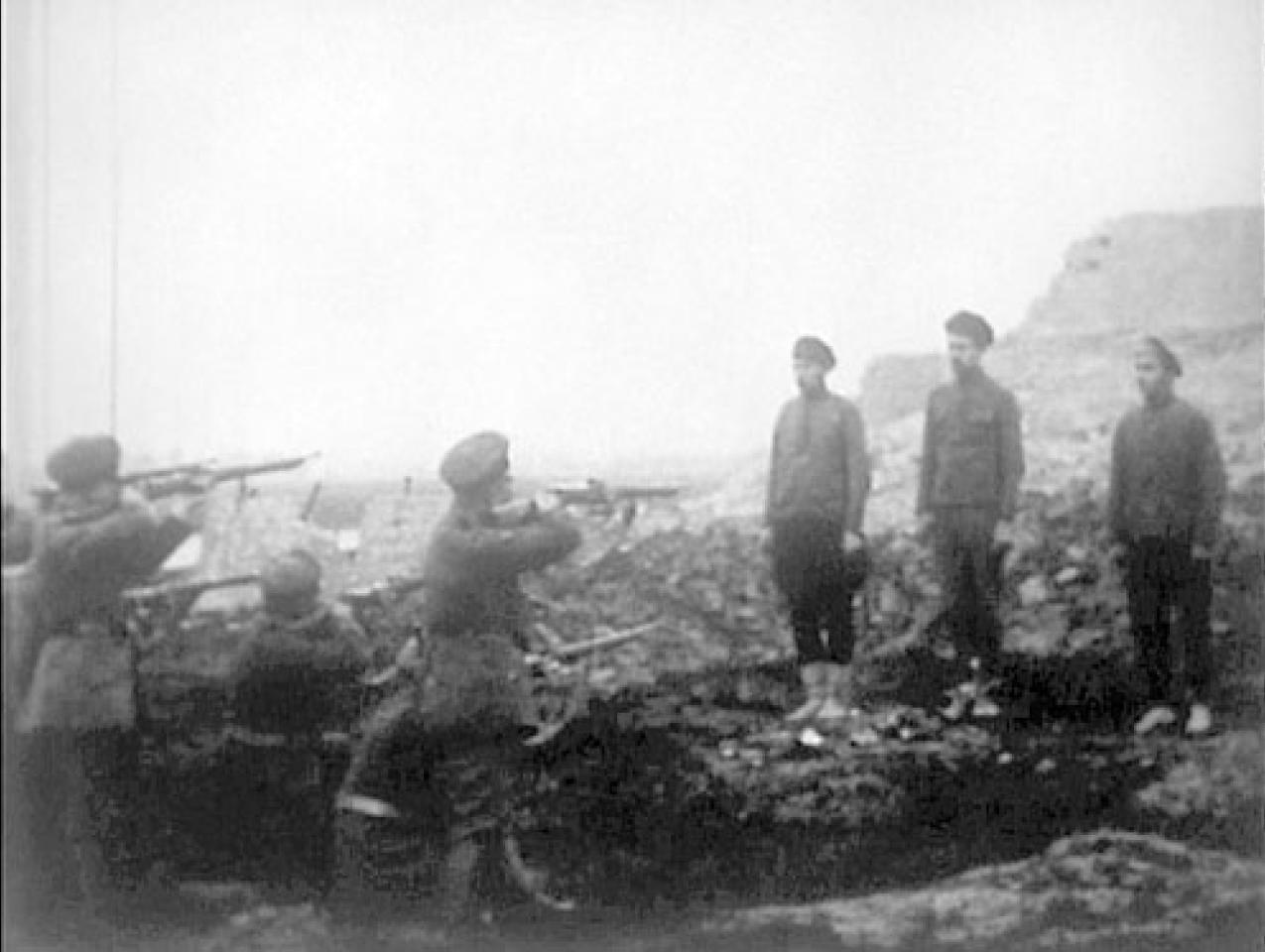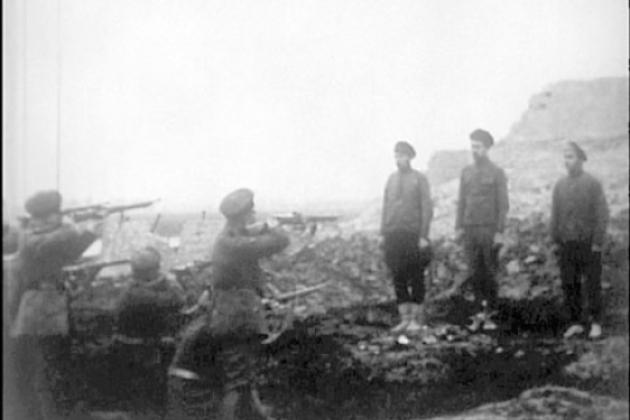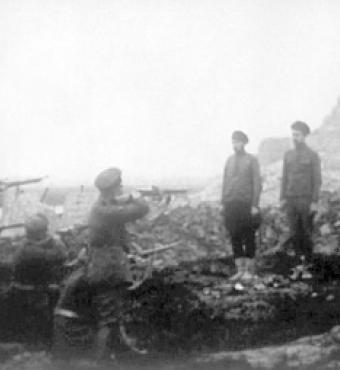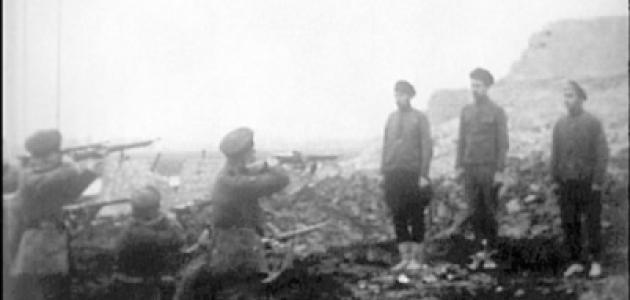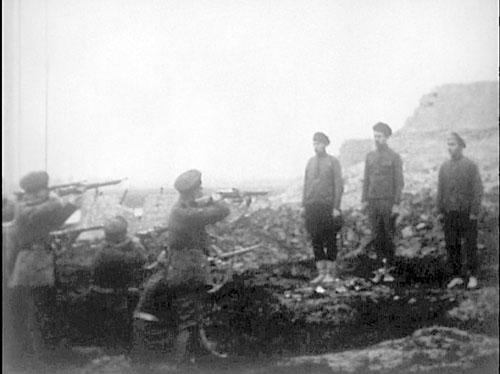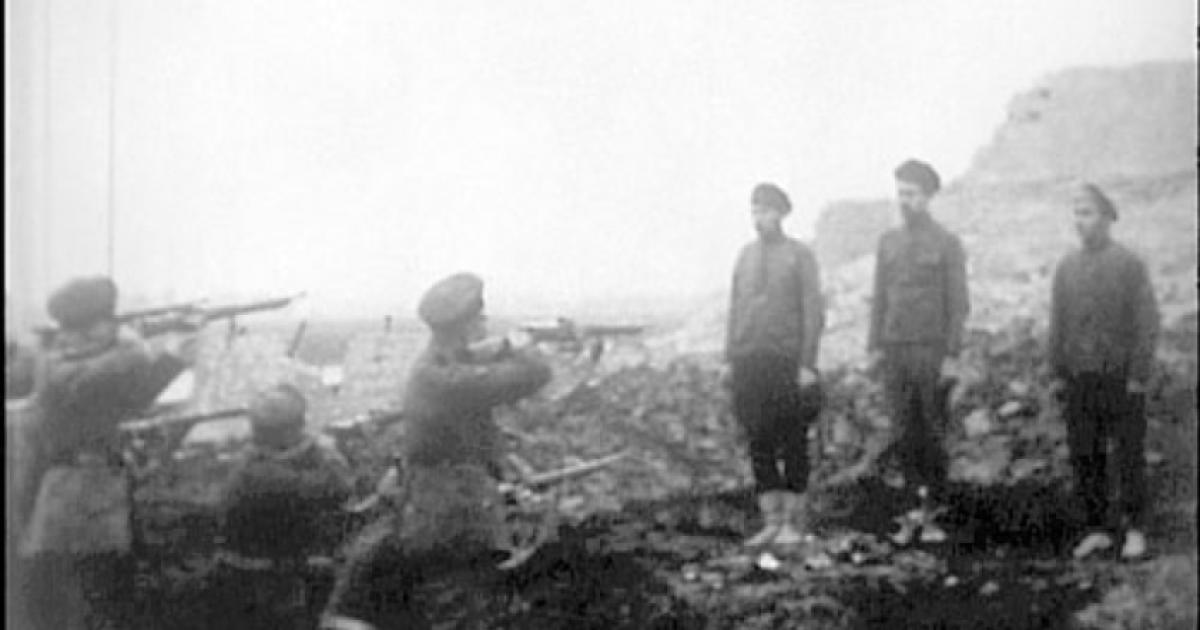In the late afternoon of May 26, 1919, in a field about thirty miles outside Riga, Latvia, a squad of nine German riflemen executed eighteen Latvian Bolsheviks. The prisoners were shot in groups of three, each victim receiving one bullet to the chest and two to the head before toppling backwards into a freshly dug grave. “It was German efficiency at its best,” wrote U.S. Army Captain Howell Foreman, an American relief worker who witnessed the execution.
Captain Foreman was one of a dozen Americans whose presence on the scene may have influenced the operations of the firing squad that day. If so, this was because one of their number, Lieutenant Frank Johnson, happened to be a newsreel cameraman. His camera recorded the scene for the ages: the reading of the death sentence, the removal of the prisoners’ boots, and the businesslike procedure of the German soldiers. In its day, Johnson’s celluloid was one of the most sensational film sequences ever shot. Even today, after decades of atrocities recorded on film and tape, the choreographed dispatch of the eighteen Bolsheviks is a spellbinder. That piece of film is today housed at the Hoover Archives, as part of the Herman Axelbank Motion Picture Film Collection. The irony is that, at its first public showing, in New York in January 1920, Johnson’s film sequence was associated with the name of Herbert Hoover.
After the armistice of November 11, 1918, Hoover had joined President Woodrow Wilson and the other U.S. diplomats serving in Paris with the American Mission to Negotiate the Peace. Among Hoover’s several roles, as head of the American Relief Administration (at that time a U.S. government agency) he had the enormous job of coordinating American food delivery throughout Central and Southeastern Europe and the Near East. The delivery of food was complicated by the persistence of military hostilities in the scramble for territory that once belonged to the German, Russian, Austrian, and Ottoman empires.
A chief concern of the Allied diplomats in Paris was that Bolshevism would fill a vacuum left by the withdrawal of the German military from the Baltic region. The Allies thus arranged for surrendered German troops to remain in place and help prevent the Russian Bolshevik infection from spreading. In the words of the official ARA history written shortly afterwards, “Bolshevism was the supreme peril, not Germany. Bolshevism was still uncontrolled and threatened the world. Germany, though still a danger, was beaten and could be controlled. At whatever cost, it must be seen that Bolshevism did not break through these barrier states.”
TURMOIL IN THE BALTICS
Latvia became the key battleground of this contest in the spring of 1919. Latvia had belonged to the Russian empire until it fell to the German invaders after the Bolshevik Revolution of 1917. Then came a brief period of independence in the wake of the German surrender in November 1918, followed in January 1919 by the establishment of a Soviet government in Riga, the capital, whose residents were subject to a furious Red Terror.
There proved to be no shortage of German soldiers on the scene to help stem the Red tide. They included a Freikorps unit that had been stationed in Riga until the Red advance, new volunteers recruited from Germany by means of vague promises of land in the Baltic, and remnants of the German Eighth Army. These units came together as the Iron Division, under the command of General Rüdiger von der Goltz. This force was supplemented by the Baltische Landeswehr, a formation dominated by Baltic Germans. The Germans were successful in their effort to drive out the Red forces, yet in the process they chased the Latvian Provisional Government from its seat in the port city of Libau (today Liepa¯ja) on the Baltic. And after Riga fell to the Iron Division on May 23, 1919, that city became the scene of a White Terror that rivaled its Red predecessor in savagery.
Hoover’s American relief workers, demobilized officers who had served with the American Expeditionary Force, were poised to enter the scene on the heels of anti-Bolshevik forces and help restore a semblance of normal life. These Americans were scandalized by the behavior and attitudes of the German soldiers, who were quick to say that while they might have lost the war on the Western Front, they had won the war in the East. The objective of the German forces, the Americans concluded, was the establishment of German supremacy in the Baltic, the gateway to Russia.
Later, after their Baltic adventure had come to an end and they had been forced to return to Germany empty-handed, these German Freebooters would claim they had been “stabbed in the back” by the Weimar government; for the time being, however, they were doing a considerable amount of shooting in the head and chest. The victims numbered in the thousands, with the heaviest toll in Riga. The Germans classified their prey as “Bolsheviks,” but while this label was no doubt accurate in some cases, as often as not it was applied indiscriminately to target uncooperative Latvians.
THEATER OF THE MACABRE
The Americans gained admission to the execution near Riga on May 26 for the price of a pack of cigarettes—at least that is the story told by the cameraman, Lieutenant Johnson. Other testimony supports his statement that the German officer in charge obliged the Americans by moving up the time of the execution so as to catch the afternoon light. The Latvian soldiers went to their deaths dressed in their military uniforms, minus their boots because at the time shoes were as coveted as cigarettes. It is unclear whether the prisoners understood before the death sentence was read out that they were to be shot. Johnson observed that “none of them ever had seen a motion picture camera before, and they stared at us, uncertain and bewildered as to whether we had brought a new form of sudden death or not.”
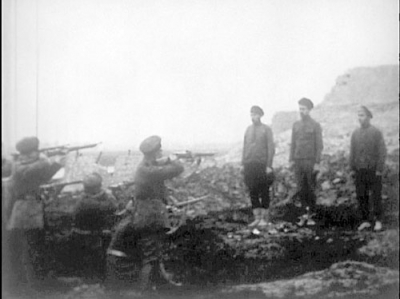
Three barefoot men face an improvised firing squad in Latvia in May 1919, moments before being shot to death and toppling into their grave. This stunning footage, recorded by an American newsreel cameraman accompanying a German occupation force, was to make an appearance in twentieth-century politics, history, and—in a grotesque way—entertainment.
One of the doomed men in Johnson’s film, however, appears undaunted by the proceedings. Ordered to lie on his stomach like his comrades, he nonetheless lifts his head and laughs at the camera. His laughter seems to be an act of defiance—or perhaps he has lost his grip in the face of looming death. In fact, this particular prisoner literally dies laughing, as Captain Minard Hamilton noted in his description of the execution:
A striking detail visible on the screen but unmentioned in eyewitness accounts is the performance of several of the victims’ hats, which, at the moment the bullets hit their mark, are launched several feet skywards before descending into the open grave after their owners. This, as well as the laughing Bolshevik’s hysteria literally on the edge of the grave, gives the sequence the feel of slapstick, an impression enhanced by the unnaturally fast speed of the 35mm film. Such thoughts may have run through the mind of the cameraman, who as head of a film production company in New York City had some theatrical experience. “I’ve taken lots of executions,” he told Captain Hamilton once the performance was over, “but they have always got up and walked away afterward.” Yet Johnson’s final shot, a look down at the tangle of victims in their mass grave, leaves no doubt that these Latvian extras would be unavailable for any future performance.
The U.S. Army officers who arrived to administer the delivery of food relief sounded the alarm to their superiors in Paris about what Johnson called “the ruthless advances of the Hun.” In order to clinch their case, they rushed Johnson’s execution film to the Peace Conference, where it was screened for the assembled diplomats. By several accounts, the scenes of the German firing squad in action helped persuade the peacemakers to order the immediate withdrawal of the German troops from the Baltic.
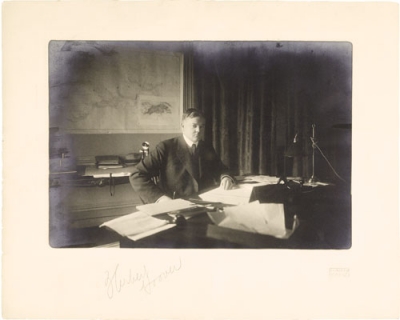
Herbert Hoover, shown in his Paris office in 1919, coordinated heroic food deliveries to ravaged Europe during and after the Great War. Later he followed up by leading efforts to feed the lands convulsed by the Russian Revolution and civil war. His work for hunger relief made Hoover widely popular, both in Europe and the United States, and led to a proposal for a documentary film to showcase American benevolence—and perhaps burnish Hoover’s political prospects. The Latvian firing-squad sequence would play an unanticipated role in that movie.
Johnson, a motion picture man with a flair for self-promotion, later boasted in a story he wrote for the Hearst newspapers that, thanks to its Paris screening, his Latvian horror film had proved to be “a deciding factor in the deliberations of the greatest legislative body of modern times. Never was a more amazing motion picture performance given, nor will such a one ever be possible again.” In Johnson’s telling, President Wilson, watching in disbelief as the Latvian soldiers are laid low, turns white with revulsion. Rising to his feet, he voices outrage at this manifestation of German brutality and gratitude to the Americans who captured it on film: “The gentlemen of the motion pictures have rendered a service to humanity!”
© © © ©
The Paris Peace Conference was only the first noteworthy performance of Johnson’s notorious film sequence. The following year it came to the big screen as part of the documentary film Starvation, a nearly two-hour compilation of footage shot by a variety of American newsreel cameramen accompanying American relief officials throughout Central and Eastern Europe in those chaotic months after the Armistice. Starvation was set to premiere at the Manhattan Opera House on January 9, 1920, and then be distributed to theaters across the country.
The impresario behind the film was ARA publicity chief George Barr Baker, a former magazine editor and longtime associate of Herbert Hoover’s who had arranged to send the motion picture men into the field alongside the American relief workers. Starvation, as the uplifting story of America’s postwar benevolence, would feature images of American relief ships steaming into ports on the Baltic and Black Seas, long lines of emaciated children and adults waiting to receive their food, children being fed in soup kitchens, and the obligatory scenes of worst-case children suffering from severe hunger and hunger-related disease.
Starvation’s subtitle was “The Camera-Drama of a Hungry World,” yet the film’s true villain was Bolshevism, which Baker identified as the “twin brother” of starvation. Thus, among the heartwarming images of American relief, room was found for Johnson’s Latvia execution sequence, as well as a chilling episode captured on film by one of Baker’s teams of cameramen in the Russian city of Pskov, where a White Russian army general arranged for the public hanging of three Bolshevik “spies” for the camera. The fact that alleged Bolsheviks were on the receiving end of this violence, and not its perpetrators, could easily be accommodated. The implicit message of Starvation was that wherever the “Bolshevik element” is allowed to gain a foothold, atrocity begets atrocity. As Baker wrote to Hoover two weeks before the film’s premiere: “The definite value of the picture is that it is the first anti-Bolshevik document possessing any potential strength with the masses. No normal mother who sees it will be likely to tolerate talk of direct action in her home.”
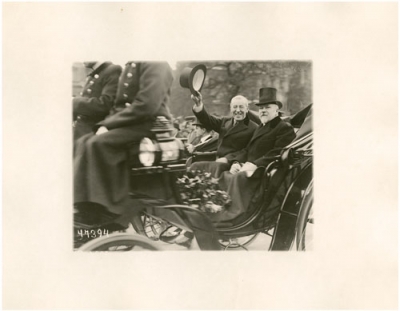
Weeks after the Armistice of 1918, President Woodrow Wilson arrives in Paris, where French President Raymond Poincaré escorts him past cheering throngs. The victorious Allies then set to work crafting the peace treaty at Versailles. Wilson viewed the Latvian execution sequence while in Paris. According to the American who shot the film, Wilson was appalled. He condemned German militarism and thanked the Americans who captured the incident, proclaiming the footage “a service to humanity.”
George H. Nash, who as Herbert Hoover’s biographer has tracked Baker’s public-relations activities and his close association with Hoover, considers it “likely that this was in effect a Hoover campaign film designed by Baker to advance Hoover’s presidential prospects in 1920.” Hoover, who had recently returned from Paris to Washington, was a rising political star. There was much speculation that he would become a presidential candidate in 1920, and even though he was serving in Woodrow Wilson’s Democratic administration, both major political parties were taking him seriously as a potential candidate. None of this was lost on Baker, who figured that Hoover’s endorsement of Starvation would be a win-win, serving to promote a film that would publicize Hoover’s postwar statesmanship and humanitarianism. On December 30, 1919, Baker cabled Hoover to ask that he allow his name to appear prominently in the announcement for the film—although Hoover himself would make only two brief appearances on the screen.
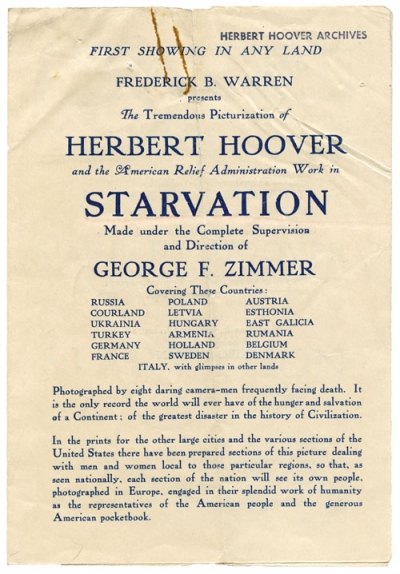
A handbill (right) announces the film Starvation, whose subtitle was “The Camera-Drama of a Hungry World.” Yet the film’s true villain was Bolshevism, which George Barr Baker, a Hoover associate who had arranged for the newsreel filming, identified as the “twin brother” of starvation. Starvation was Baker’s brainchild. Nearly two hours long, it was a juxtaposition of heart-warming images and scenes of brutality and want. It premiered in New York in January 1920, with Herbert Hoover’s name prominently featured in its advertising.
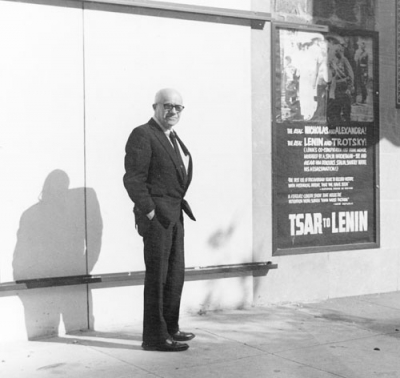
Herman Axelbank was an avid chronicler of the end of Imperial Russia and the dawn of the Soviet Union. A film enthusiast who launched his career as an office boy for Goldwyn Pictures, Axelbank sent camera crews to Russia to film Lenin, Trotsky, and key moments of the post-revolutionary era, and collected older footage of the war and the Romanovs. Tsar to Lenin (1937) assembled much of that footage—including the Latvian execution sequence— into what became Axelbank’s only serious documentary project. Axelbank’s impressive collection resides in the Hoover Archives.
Edgar Rickard, another Hoover confidant associated with American food relief, was skeptical, warning that Baker’s film, far from giving a boost to Hoover and the ARA, might well boomerang. As Rickard reasoned, “One picture of children’s feeding is just like another, no matter in what country it may have been taken, and the only films which have come over, particularly Lieutenant Johnson’s films, are so filled up with Bolshevist outrages and atrocities of the Germans that we could not possibly stand for them.” Rickard was also sensitive to the mood of the American people in an election year. “From now until November of next year the entire country will be completely swamped in a presidential election,” he observed, which meant that the American public was turning inward, especially at a time of deepening economic recession. “The whole country is absolutely and thoroughly sick of the European war and has settled down to a definite fight on domestic problems which are very serious.”
Baker won the argument, and Hoover’s name appeared in large print on the opening-night announcement for Starvation. The premiere, on January 9, 1920, was preceded by an aggressive publicity campaign carefully coordinated by Baker. His preparations paid off, as the chief movie review outlets of the day all came through in the way he had hoped. Variety praised the film as a record of America’s “work of humanity” and “also a stirring object lesson why America should not permit the radical element to obtain a hold and over throw any of the present governmental institutions.” According to Photoplay, “The picture is calculated to make you want to help feed the starving nations. It very likely will.” Moving Picture World applauded the film for bringing to vivid life the story of how “America erected a bulwark of food to stem the tide of the Bolsheviki.”
These and similar reviews may have cheered Baker, but he knew better, because he had been at Starvation’s premiere and had seen for himself the depressing effect the film had produced on its audience. People were shocked by what they saw on the screen, but not in the way Baker and the filmmakers had intended. The reviewer for the New York Times, echoing a complaint of many others in attendance, noted that while the many scenes of American mercy were heartwarming, the film “unhappily and irrelevantly dragged in ghastly executions of Bolsheviki by German firing squads, and even more excruciating hangings of Bolsheviki for some unnamed crime by some unnamed enemy.” Such scenes “left one cold with an unameliorated terror.”
Baker recognized that the Times reviewer was correct, and that he and the film’s producers had miscalculated. Concerned about having associated Hoover’s name with what was shaping up to be a serious flop, Baker could take comfort in one sentence in the Times review: “These pictures, ‘photographed through the assistance of Herbert Hoover,’ give no internal evidence of having passed under his eye in their final form.” More consolation came in the form of Variety’s only reservation about the film: “As a picture it may be propaganda for the coming boom to secure the presidential nomination for Herbert Hoover, but there is so little of Hoover in the picture that if it is propaganda for him it is of the most subtle sort.”
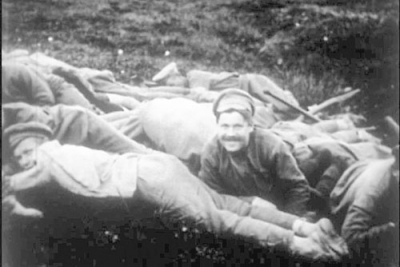
In an inspired bit of editing for Tsar to Lenin, the “laughing Bolshevik”—the condemned prisoner who faced death with bizarre levity—is among the last group of three to be shot, enabling the narrator, Max Eastman, to heighten the tension as each trio is executed. “The Red soldier is still laughing!” Eastman intones, as the prisoner, taunting his executioners, makes his exit.
The distance between Hoover and Starvation in the public mind was just about the only good news that Baker could report in his letter to Hoover of January 13, four days and eight performances after the premiere. By then the film had been recut and shortened and its run in New York scheduled to end within a few days. “I said that I would not get you into trouble,” a chastened Baker wrote to Hoover. “I have not done so. The enclosed clippings indicate that the public is not led to believe that you have any interest in the film.”
THE FOOTAGE LIVES ON
Starvation never made it beyond New York City. No print of the film survives, although Johnson’s execution sequence was salvaged and eventually landed in the Hoover Archives. It may not be the first execution ever captured on film, but it may well be the oldest surviving such footage. It has appeared in numerous documentary films about World War I and the Russian Revolution over the years, often improperly identified as visual evidence of Whites slaughtering Reds during the Russian Civil War. This is no doubt due in large part to Max Eastman, the socialist writer and former associate of Leon Trotsky who, in editing the 1937 documentary film Tsar to Lenin, identified the executioners as soldiers of the White Russian army under Admiral Alexander Kolchak. Eastman also contrived to heighten the drama of the sequence by manipulating the images. Instead of taking his place among the first trio of victims, the laughing Bolshevik, after nine of his comrades have been shot dead, is shown looking up from the ground and cackling, in what is meant to be a spine-tingling cutaway shot. Thanks to the editor’s handiwork, the laughing Bolshevik exits last, taunting his executioners to the end, as narrator Eastman intones: “The Red soldier is still laughing!”
Baker, together with Rickard, would help get Herbert Hoover elected to the White House in 1928. By then he had recovered from the considerable financial loss he took as a result of Starvation, a total of nearly $11,000. He never recovered his enthusiasm for moviemaking. As he wrote a New York state tax auditor a few years after his cinematic debacle, “My advice to a young man about to risk money in a motion picture is—‘No.’ ”








